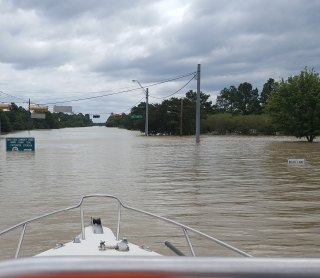In August 2017, Hurricane Harvey caused damage to homes and buildings across 49 Texas counties, flooded highways, and overflowed streams, rivers, and reservoirs. In addition to the Category 4 storm setting the record for the most rainfall at 55 inches, Hurricane Harvey is also ranked as one of the costliest natural disasters in U.S. history to date.
SWCA’s Houston office was deeply impacted, with an unexpected office closure and several staff members’ homes flooded. In the days after, staff spent time giving back to those in need by donating supplies, volunteering at shelters, and rescuing people.
On September 8, 2017, President Trump signed a bill approving $15.25 billion in storm aid for Hurricane Harvey relief. Once federal aid is awarded, many people wonder what happens next. How will the money be disbursed and used?
ALLOCATING FEDERAL RELIEF FUNDING
After an especially large disaster, Congress will allocate federal funding to help the affected communities recover. These funds are channeled through the Community Development Block Grant Disaster Recovery (CDBG-DR) Program, which is administered by the U.S. Department of Housing and Urban Development (HUD). The funds are then provided to the state that was impacted.
The Texas General Land Office (GLO) is the agency responsible for administering CDBG-DR, which includes creating safeguards and program guidelines to ensure taxpayer dollars are spent wisely. Primary guidelines include the requirement that every project has an environmental review to verify it complies with HUD’s requirements. This involves compliance with the National Environmental Policy Act (NEPA), and through this a wide net of other regulations are included, such as the Clean Water Act (CWA), the National Historic Preservation Act (NHPA), National Flood Insurance Program, the Environmental Protection Agency (EPA) and state requirements on lead-based paint, asbestos and hazardous materials, airport clearance zones, and many others. HUD requires every project to be reviewed and verified that it meets all the applicable environmental regulations. If this doesn’t happen, then HUD will not send the funds.
A TEAM EFFORT
With the requirements outlined by HUD, the question becomes what areas of the environment are most affected? When will the community receive the funding? And how exactly will it be put to use?
SWCA is contracted by the Texas GLO as their primary environmental service provider for all Hurricane Harvey related disaster recovery programs. More than 20 full-time staff members across SWCA’s Houston, San Antonio, and Austin offices are responsible for reviewing all the environmental compliance documents that are prepared by the contractors who are rebuilding damaged homes, multifamily buildings, and infrastructure. In some cases, the damage requires field studies to be performed such as archaeology and architectural history assessments, wetland delineations, soil testing, and more. Environmental monitors then verify that the work performed meets the environmental site conditions placed upon the project.
The recovery funding is primarily allocated towards low-to moderate income areas, where the affected residents had less money to help themselves through private insurance, or where infrastructure is located. Currently, SWCA is reviewing approximately 250 individual environmental applications for single family residential recovery programs a week and performing environmental assessments on multi-family and large-scale infrastructure projects throughout East Texas.
“From the start, this project was envisioned as a multi-office effort, and needed to be given the project’s size,” says Rob Lackowicz, San Antonio Office Director and Deputy Program Manager for single family housing disaster recovery projects funded by the Texas GLO. “These applications spread through 49 affected counties in the Houston area and we expect to review about 300 a week before the end of the year.”
LOOKING AHEAD
The review process of applications is expected to last at least another two and half years, with 20,000 total projects requiring environmental review. “We all feel this as a substantial responsibility,” says Lackowicz. The goal is to develop and implement practical and effective environmental policies that expedite, rather than hinder, the disaster recovery process; to provide complete environmental reviews in a fast yet accurate manner, so that communities can get back on their feet.
For more information on our disaster recovery services, click here.
